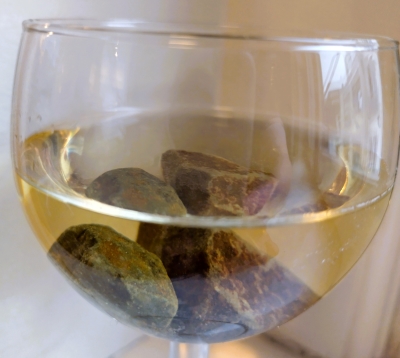Minerality
Over the last few days, I have been seeking a clear definition of minerality in wine. Minerality can be describe as a peculiar sensation that one can experience when drinking certain wines, such as Pouilly Fumé or Irouléguy Blanc, but also this strange flinty smell or “Pierre à Fusil” that may occur with other wines. I initially searched for a definition in a French dictionary using the French translation of minerality (“Minéralité”), but to my surprise, the word was not found. I then consulted the Oxford dictionary but had the same result.

Minerality is among the most undefined wine terms, Put 10 wine experts in the same room and the result will be 6 different definitions, and one person arguing that minerality is simply a myth. This word, minerality, is really recent, from the ’80s or the ’90s, and is limited to some people. So, what is behind the minerality in wine?
I thought I knew the answer, having grown up in an area between the Bandol and Cassis appellations where calcareous soils of the Cretaceous dominate. As a child, I recall running in the hills and scrubland and licking some rocks from there. Odd, isn’t it?
I believed that minerality in wine was a similar flavor, but how could that be? To be sure, I conducted the ultimate experiment of licking and smelling some calcareous rocks (which I cleaned) while tasting a Chablis. The result was that the rocks had no scent, and there was no noticeable taste, only a hazy sensation of salt. For the wine, the mineral aspect was more of a sensation, a light bitterness associated with a dry sensation different from the effect that young tannins create, and finally a pleasant salivation. The only way I can describe it is as the sensation of having rocks in your mouth, which is a good image, but not entirely accurate.
However, this description is considered the best one, but it still doesn’t explain minerality. Because when you think of it, how can you find rocks in grape berries? There is no way!
Of course, vine roots extract oligo-elements and nutrients from the soil with the help of fungi, which have a symbiotic relationship with them. They end up in the form of organic molecules in the plant sap. These molecules do not create minerals inside the fruit, but instead, help to produce aroma precursors, tannins, or other proteins and carbohydrates that give a wine its identity. This is the link between soil, minerals, and wine. But, in any case, they will not create rocks or anything similar.
How can we explain what minerality is? Most of the molecules in wine produce primary aromas, carbohydrates, acids, phenols, and tannins, but no minerals. We are missing a definition. Usually, minerality is described as a bitterness associated with a light astringency in the mouth, with salivation often compared to having pebbles in the mouth. As I assume most people are not like me and do not try to taste rocks, let’s stick with this definition. This sensation could be compared to a few grains of salt on a slice of meat that enhance your mouth and make you salivate.
On the nose, minerality is often described as an odor of flint, diesel, and seafood shell. It may or may not be associated with the previous sensation. Therefore, stone, flint, petroleum, and other mineral aromas are not called primary aromas. They do not come from the fruit and are not the direct product of the vine, but rather the result of the works of bacteria and yeast.
So, the mystery remains unresolved, but there are a few explanations:
Minerality in wine has long been a mystery, and there are various hypotheses to explain it.
One explanation is that mineral wines may contain free ions that are absorbed in the soil with water, which the roots can take up. These ions are subtle in taste, but they can contribute to the wine’s minerality. However, this does not fully explain the aroma and mouthfeel associated with minerality.
Some people believe that mineral wines are mineral because they lack other flavors, but this is not a satisfactory explanation. A wine with no flavor or taste is simply a passable wine and should not be described as mineral.
Another possible explanation is the presence of complex organic sulfides and thiols, which are sulfur analogs of alcohols. They can produce a range of odors, from garlic and flint to skunky for faulty wines. These compounds are a result of yeast’s reaction with sulfur during fermentation, and they may contribute to the flinty and diesel-like aromas associated with minerality.
An experiment conducted by researchers revealed some of the root causes of minerality in wines and linked it to one compound, succinic acid. They tasted the amount of succinic acid in wine considered mineral and not mineral wines. The result, the more succinic acid it contains the more minerality is found. Succinic acid is one of the products of fermentation, it is a non-volatile acid, and you can’t smell it. Wine can contain between 0.5 g per liter to 3 g per liter, and it is generally described as a mixture of acidity, saltiness, and bitterness. This may contribute to the mouthfeel associated with minerality.
In summary, minerality can be resumed by an aroma that reminds flint or petroleum and a sensation in the mouth. Nothing directly linked to minerals. But it doesn’t mean that the soil is not involved. Some minerals are absorbed directly with water if they are in form of ions and minerals could be also absorbed in form of oligo-elements by the roots helped by fungus. This will result in several precursors but also some nutritive stress able to produce the salivation linked to minerality. Some soils, limestone, and volcanic soils are known to produce mineral wine. Minerality can be a desirable characteristic in wine as it can add complexity and depth to the wine.